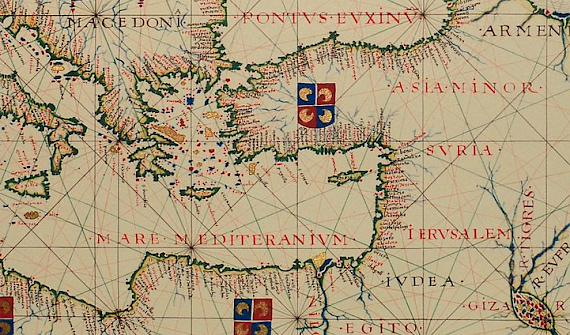The Count, the Monastery and the Saint: Warfare in the Medieval Near East
The aftermath of the First Crusade would leave the Near East with an abundance of rivalries. The European Crusaders who had carved out states for themselves not only had to fight against Turkish and Egyptian forces, but also had to deal with Eastern Christians who often had a strained relationship with the newcomers.

Gregory Bar Hebraeus (1226-1286) is one of the most important scholars from the region, offering an account of events from the perspective of a local inhabitant. His Ecclesiastical History includes this episode from 1148, involving Joscelin II, Count of Edessa. This crusader lord had recently lost his main city, but was still looking to go to war with the Turks. The story begins:
In the same year Joscelin the Frank, the lord of Edessa, gave way to a wicked impulse. He assembled his forces, and after announcing his intention of going up to plunder the lands of the Turks, came to Harran. Then he went up into the White Mountain, where he remained for three days, until he was recognized by the people of the region and fled. Then he said to his captains: ‘Since our march has been troubled, let us go to the nearest monastery, offer a prayer there, and then turn back.’
The crusaders headed to the monastery of Mar Barsawma, which was near the city of Malatya in what is now eastern Turkey. As Joscelin approached the Jacobite Christian monks came out with crosses and gospels to meet him. However, the count then revealed his true intentions for coming here - he sent in some of his soldiers to search the monastery, and had the rest of them seize the monks. Bar Hebraeus continues:
Then he began to abuse them: ‘You put to flight the inhabitants of Qlaudia,’ he said. ‘Give me everything that was entrusted to you from the Turkish territories. I know you have hidden it here somewhere.’ The monks replied that if they did that, they could no longer live there. He angrily drove them out of the church and imprisoned them in the prison known as Kana. Then he sent the Frankish priests into the temple, who took away whatever they found: golden chalices, platters, glasses, crosses, thuribles, candlesticks, fans, evangelaries, books and parchments. They also plundered the cells and collected whatever gold, silver, bronze, iron, clothing and carpets they found.
The looting of the monastery only stopped for a short while, and then the Count ordered his men back into its cells to make an even more thorough search, even going up into the roof. Fifty monks were then led away, as was one of the monastery’s most prized possessions - the right arm of Mar Barsawma, a fifth-century saint. According to Bar Hebraeus, these actions would prompt the saint to appear in the dreams of three soldiers, telling them:
“Go, and tell your king that I was angry with my monks, and delivered them into your hands so that you might afflict them, and that they might repent and be converted. Now let them return to the monastery.”
The soldiers reported their dream to Joscelin, but the Count refused to release them unless the captives paid a ransom. Eventually, Mar Barsawma would return:
Then some of the king’s servants saw a vision of a fiery sword held out from a citadel, in which was the saint’s right hand, and heard a voice saying: ‘I tell you Joscelin, unless you release my monks, I will destroy you and your kingdom with this sword.’
After this Count Joscelin agreed to release the monks, but only after they paid a fine of 5,000 dinars. By the time the monks had returned to their monastery over fourteen months had passed.
Afterwards, it seems that the saint was more friendly to the Crusader count:
Meanwhile Joscelin was besieged by a Turkish force in Tel Bashir. Then, on his order, they held the saint’s right arm above the wall and brandished it in the direction of the Turkish camp, while all the people stood by and wept with bared heads. Joscelin vowed that if he captured the enemy camp, he would send the right arm back to the monastery and would return all other things he had plundered. The Turkish camp was stormed and captured in that very same hour, so Joscelin sent to the monastery and begged for forgiveness. The oldest monks led the saint back to the monastery in solemn procession. They entered the monastery at the beginning of January, on the feast of the Holy Doctors.
 While the episode seems to have a satisfactory conclusion for the Jacobite monks, the story of Count Joscelin II would not have a happy ending - in 1150 he was captured and brought to Aleppo, where he would be publicly blinded and left in prison until he died nine years later.
While the episode seems to have a satisfactory conclusion for the Jacobite monks, the story of Count Joscelin II would not have a happy ending - in 1150 he was captured and brought to Aleppo, where he would be publicly blinded and left in prison until he died nine years later.
The Ecclessiastical Chronicle of Bar Hebraeus has just been translated by David Wilmshurst and published by Gorgias Press. Click here for more details. Bar Hebraeus’ Syrian Chronicle was translated in 1932 and can be read online, including here.
You can read more about warfare in the medieval near east in our Issue VI:1 - Reign of the Leper King: The Kingdom of Jerusalem
